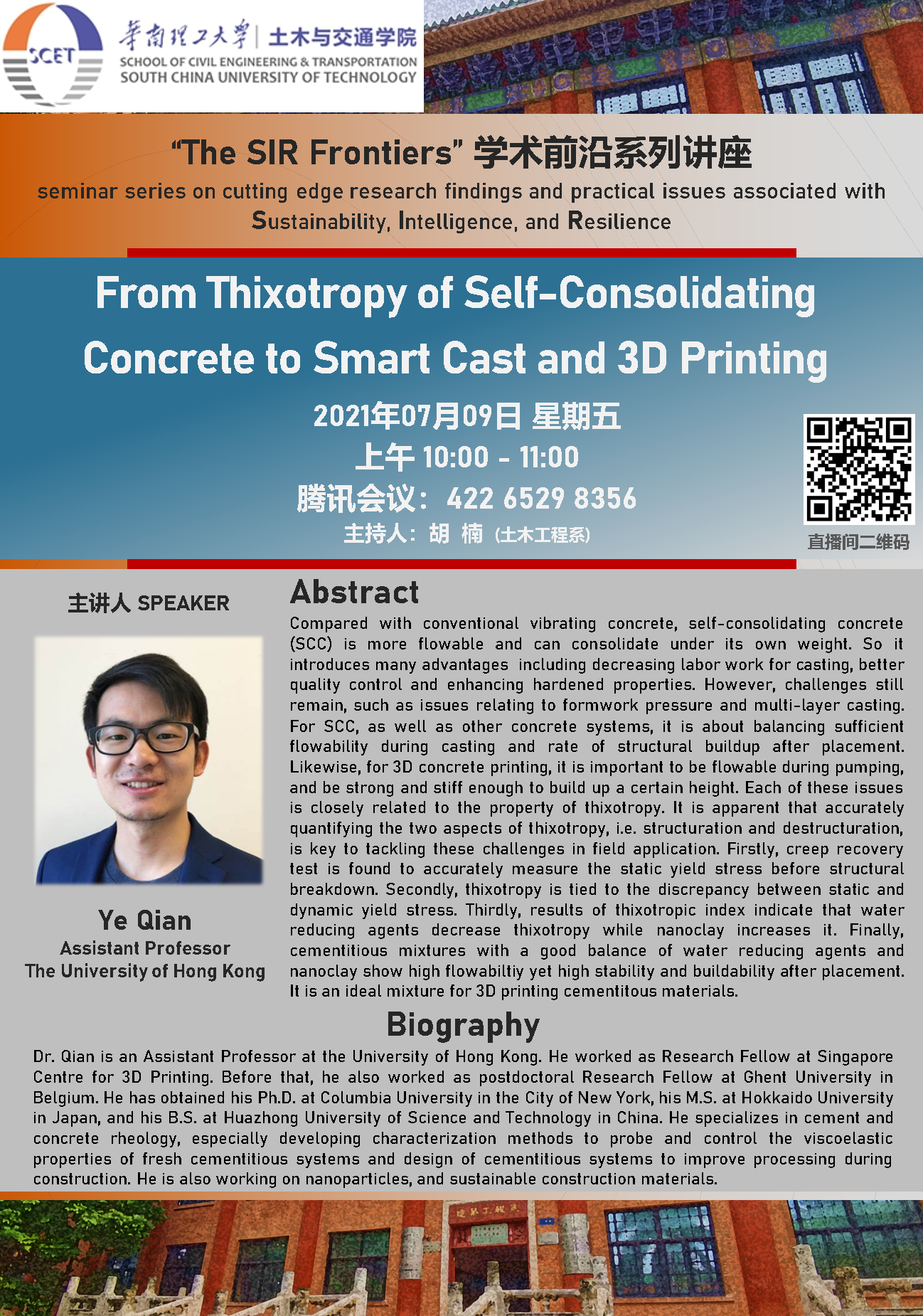题 目:从自固化混凝土的触变性到智能浇铸和3D打印
时 间:2021年07月09日10:00-11:00
地 点:腾讯会议 ID:422 6529 8356 (若300人满请入直播间)
腾讯直播间:https://meeting.tencent.com/l/QALGLWoVMAcS
报告人:钱野助理教授(香港大学,土木工程系)
官方主页:http://www.civil.hku.hk/pp-qiany.html
欢迎广大师生参加!
土木与交通学院
2021年7月6日

报告人简介:
钱野博士目前是香港大学土木工程系的助理教授,在此职位之前,他曾任新加坡3D打印中心研究员,以及比利时根特大学博士后研究员。钱教授先后在华中科技大学获得学士学位,在日本北海道大学获得硕士学位,在美国哥伦比亚大学获得博士学位。他的研究领域为水泥和混凝土流变学,特别是开发表征方法来探测和控制新胶凝体系的粘弹性性能和设计。
更多详情请参阅: http://www.civil.hku.hk/pp-qiany.html
Dr. Qian is an Assistant Professor at the University of Hong Kong. He worked as Research Fellow at Singapore Centre for 3D Printing. Before that, he also worked as postdoctoral Research Fellow at Ghent University in Belgium. He has obtained his Ph.D. at Columbia University in the City of New York, his M.S. at Hokkaido University in Japan, and his B.S. at Huazhong University of Science and Technology in China. He specializes in cement and concrete rheology, especially developing characterization methods to probe and control the viscoelastic properties of fresh cementitious systems and design of cementitious systems to improve processing during construction. He is also working on nanoparticles, and sustainable construction materials.
报告摘要:
与传统的振动混凝土相比,自密实混凝土(SCC)更易流动,并能在自重的作用下固结。因此它在建筑应用中引入了许多优势,包括减少铸造劳动、更好的质量控制和提高硬化性能。然而,挑战仍然存在,例如与模板压力和多层浇铸相关的问题。对于 SCC 以及其他混凝土系统,它是关于平衡浇筑过程中足够的流动性和浇筑后结构堆积的速度.同样,对于 3D 混凝土打印,重要的是在泵送过程中具有流动性,并且使混凝土足够坚固和坚硬以建立一定的高度。这些问题中的每一个都与触变性密切相关。
钱博士将介绍如何准确量化触变性的两个方面,即结构化和破坏性,也是解决现场应用中这些挑战的关键。首先,发现蠕变恢复试验可以准确测量结构破坏前的静态屈服应力。其次,触变性与静态和动态屈服应力之间的差异有关。触变性越高,差异越大。因此定义触变指数以有效量化触变性。第三,触变指数结果表明,减水剂降低了触变性,而纳米粘土增加了触变性。最后,具有良好平衡的减水剂和纳米粘土的水泥混合物在放置后表现出高流动性、高稳定性和可施工性。它是3D 打印胶结材料的理想混合物。
Compared with conventional vibrating concrete, self-consolidating concrete (SCC) is more flowable and can consolidate under its own weight. So it introduces many advantages including decreasing labor work for casting, better quality control and enhancing hardened properties. However, challenges still remain, such as issues relating to formwork pressure and multi-layer casting. For SCC, as well as other concrete systems, it is about balancing sufficient flowability during casting and rate of structural buildup after placement. Likewise, for 3D concrete printing, it is important to be flowable during pumping, and be strong and stiff enough to build up a certain height. Each of these issues is closely related to the property of thixotropy. It is apparent that accurately quantifying the two aspects of thixotropy, i.e. structuration and destructuration, is key to tackling these challenges in field application. Firstly, creep recovery test is found to accurately measure the static yield stress before structural breakdown. Secondly, thixotropy is tied to the discrepancy between static and dynamic yield stress. Thirdly, results of thixotropic index indicate that water reducing agents decrease thixotropy while nanoclay increases it. Finally, cementitious mixtures with a good balance of water reducing agents and nanoclay show high flowabiltiy yet high stability and buildability after placement. It is an ideal mixture for 3D printing cementitous materials.



